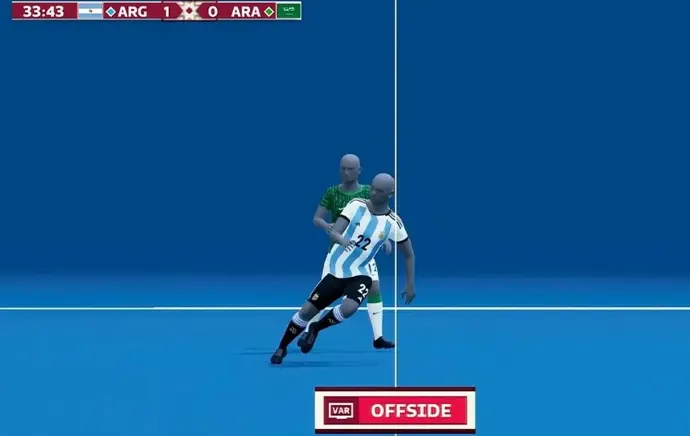Artificial intelligence, machine learning and big data are increasingly present in training, matches and injuries to footballers. The pitch turned into a laboratory threatens chance as the essence and protagonist on the field of play.
There are those who claim that Qatar 2022 is the most scientific and technological World Cup in history. And they are right because the devices, gadgets and software available to football today are unprecedented. Apocalyptic and integrated, leaning on one side and the other of the coffee bar, will discuss for several more years to reach the conclusion about whether this phenomenon worsens or improves sports practice. Meanwhile, FIFA is launching a flood of innovations that are reviewed below.
The first aspect to highlight - which Argentina knew how to suffer during the first match with Saudi Arabia - was the implementation of the semi-automated offside. Behind this machinery (perverse for many and effective for many others), there are a total of 12 cameras, strategically placed in each stadium to record the movements of the ball, as well as to capture 30 points of analysis on each player. The data they condense is sent instantly, in order to identify, for example, an offside.
The ball (named Adidas Al Rihla), for its part, has an Inertial Measurement Unit sensor. A chip sends 500 pieces of data per second that are received by the VAR room, which is in charge of processing the information. From the referee's booth, in the second instance, they manually review values such as the impact of the ball and the positions of the players, and communicate them to the referees who are on the field at the time of making decisions. As a last resort, after a few minutes, the plays are reconstructed using 3D technology and projected in stadiums and on TV broadcasts. Masochism gains a few kilos while spectators learn to suffer in installments.
However, thanks to the contributions of artificial intelligence and big data, developments are used both to minimize the errors of the refereeing team, as well as to speed up the decisions of the VAR. However, for the moment, shortly before the round of 16 begins, this last objective is not confirmed. Extra time is added to each match on average to 7/10 minutes, a much longer period than is usually seen in national and international leagues played by clubs.
One of the main people responsible for these changes is the former French coach Arsene Wenger, a reference for FIFA's World Football Development Department. Together with scientists, big data experts and engineers, he gathers and crosses a huge amount of information to create statistics: from traditional ball possession, to recovery time, the breaking of rival lines and the turnovers caused.
Machines that treat injuries
Even injuries during this World Cup are treated with new technologies. Neymar suffered a sprain during the first match between Brazil and Serbia and had to be substituted. As he is the most important player in the team led by Adenor Bacchi (popularly known as “Tité”), he has caused concern among football fans.
Fortunately for the protagonists of the game, however, there are new devices that allow for quick and complete recoveries. The Brazilian star uses a black boot that includes a touch screen and an application that, via Bluetooth, is managed from the cell phone. It automatically performs three types of massages with the purpose of improving blood circulation. The innovation, developed by the company NormaTec, “stimulates venous return, reduces swelling and relieves pain” and, in part, replaces some of the work that was previously performed by a physiotherapist.
Fontanarrosa had already anticipated it
The hyper-technologisation of football was already anticipated by Roberto Fontanarrosa in the story "Football and Science", published in the book The Greatest of My Defects (1990). There, in an ironic tone, he postulates the transformation of sport, which in a few years would be in a position to do without referees on the field of play. From here, he proposes the hypothesis of a "remote referee". Any similarity with the VAR system, at present, is mere coincidence.
“Indeed, just a hundred metres from the charming Oberhausen stadium, the spectators could see a mysterious cement construction, tubular in shape, which reached the respectable height of 75 metres. This tower did not represent any advantage, and could be confused more with a modern monument, or with some emblematic reminiscence of Nazi majesty than with what it truly was: the computerised control centre from which the match was directed.” And Fontanarrosa continues: “The curious spectators at the match could not have guessed that, beneath their feet, an intricate tangle of cables, electronic sensors, wireless filaments and computerized terminals linked the stadium itself with the referee tower.”
The old desire that Dante Panzeri proclaimed in his classic “Football, dynamics of the unthinkable” (1967) seems to have been left behind. Time will be witness and will decide whether, indeed, science, rationality, data, neatness, the asepsis of the field converted into a laboratory, will grant more justice, or whether, on the contrary, it will put an end to the essence of the most popular cultural spectacle of all time.

 IHRO NEWS
IHRO NEWS

